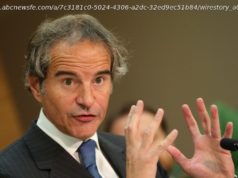Nine days, five countries, and more than a dozen outfits: the first lady makes a statement abroad.
And so we come to the end of what has been the longest and most comprehensive viewing of Melania Trump playing the role of first lady since her husband’s administration began: nine days, five countries, more than a dozen outfits, all of them photographed and recorded (and exclaimed over) for the historical record.
“Melania did not wear a veil in Saudi Arabia!” “Melania did wear a veil to the Vatican!” “Melania changes outfits during flight!”
Does it really matter?
Of course. Because Mrs. Trump has been, up to now, a cipher cloistered in a gilded New York penthouse but is about to take her place in the East Wing (at least according to her team) as the United States’ official hostess. And because, as a representative of the country and the Trump administration on the world stage, this was her clearest statement yet about how she will manage that position.
It just happened that, since Mrs. Trump did not say much as she accompanied her husband from Saudi Arabia through Israel to Italy, Brussels and Sicily, it was largely made through her clothes.
That’s why what she wore received so much more attention than what Ivanka Trump wore (the fascinator at the Western Wall and the weirdly bridal black tulle veil at the Vatican aside) .
Add up the Stella McCartney black jumpsuit, the Michael Kors gingham coat dress, the Ralph Lauren khaki shirtdress, the taupe Maison Ullens suit and the myriad Dolce & Gabbana cocktail laces, that brand’s gambler’s trouser suit and botanical day coat, and what do you have?
Ambivalence and armor. They were the defining trends of the trip.
For every moment when Mrs. Trump seemed to engage with the historical precedent of her job — which largely involves humanizing the president by being the approachable, accessible half of the equation, and participating cheerfully in the spousal exercises of dressing, dining and hospital visiting — there was another in which she seemed to reject it. Kind of the way she seemed to reject most public displays of affection with her husband until the final leg of the trip. (See the hand-swatting maneuver performed after landing at Ben-Gurion International Airport in Israel, and similar evasive tactics.)
She acknowledged, for example, the sartorial protocols of the countries she visited. In Saudi Arabia, she was modest — even the Dolce & Gabbana white trouser suit and black shirt, while with a modern edge, was fully covered. In Vatican City, she went dark. In the resort town of Taormina in Sicily, springlike.
After landing at the King Khalid International Airport in Riyadh, Saudi Arabia, she materialized on the steps of Air Force One in that black jumpsuit, whose Wonder Woman gold Saint Laurent belt, flowing hemline, long sleeves and notch neck made everyone think: abaya! Later she swept into dinner wearing a caped magenta Reem Acra gown with a jeweled neckline, like a high fashion Scheherazade.
Like many of her Western predecessors, she went veil-less in Saudi Arabia, but bent to Vatican tradition by wearing a lace veil to meet the pope. This apparent discrepancy in attitude got a lot of people very worked up, but it was fully in line with the policies of those who had gone before. (See: Michelle Obama, veil-less in Saudi Arabia in 2015, veiled at the Vatican in 2009.)
And her embrace of the high-end, and refusal to go through the motions of adopting the occasional accessible item, was fully in line with her husband’s gold-toned dollar-sign spiel. Forget espadrilles or T-shirts; the Dolce & Gabbana floral coat cost an unapologetic $51,500.
But then she rejected the traditional game of fashion diplomacy in which first ladies have been engaged since Jacqueline Kennedy, eschewing any pressure either to use her public appearances to promote homegrown talent, or to follow more recent strategy and support designers from the host country, the better to demonstrate friendly intentions.
She didn’ t ask one designer, like Hervé Pierre, who created her inauguration dress as well as the leather skirt she wore to depart Washington, to help her assemble her wardrobe. She didn’ t underscore her own international story. She spread her endorsements — but only kind of, wearing multiple looks from Mr. Kors and a high percentage from Dolce & Gabbana as well as an assortment of other names. Yes, she wore American designers, and yes, she started to look like a Sicilian widow while in Italy, and wore the Belgian label Maison Ullens in Brussels. (And, according to Vogue, which pretty breathlessly chronicled this trip, she even worked with the latter on her look, proving it was an entirely conscious choice.)
But then she undermined the point by wearing Dolce & Gabbana and the British label Roksanda in Israel, and more Dolce in Brussels. (Dolce, which she also wore for her official portrait, is seeming like her go-to brand, a relationship that has upset some of the designers’ Instagram fans.) That meant there was no consistent pattern behind the origin stories of what she chose when.
If anything seemed to unite the sartorial choices the first lady made, at least during the day, it was a certain rigidity of line, monochrome palette and militaristic mien. She favored sharp power shoulders, single-breasted jackets with wide cinched belts and big square buckles, straight skirts and a lot of buttons. Mostly buttoned up. Hemlines were not too short, and the only skin really exposed was on her arms (also a bit of shoulder in Brussels for evening) .
It’s not an accident that the Michael Kors white suit she wore in Israel looked almost identical to the Maison Ullens taupe suit she wore in Belgium: tight, belted, undecorated. These aren’ t clothes designed (in all senses of that word) to charm; they are designed for security. Though the veil debate and the floral froufrou got the most attention, it was her battened-down, ready-for-battle styles that left the lasting impression.
And raised the unavoidable question: For what battle, exactly, is she preparing? Theories have been floated: her husband’s critics; the prying eyes of the outside world; even her own marriage.






